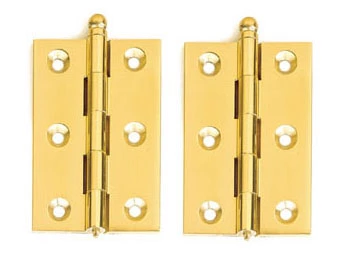Introduction and Selected Points of Door Hinges
Posted: May 27, 2015 Hits: 1609
Door hinge is a device that allows the flexible turning or pivoting of a door for opening or closing. Because door hinges are often used, choosing good quality door hinges is very important. How to choose such quality door hinges is described below:
1. Checking surface. Check if surfaces of door hinges are smooth and flat. If not, they are maybe produced with waste materials or leftover materials, leaving unpleasant appearance and degrading furniture quality.
2. Checking hydraulic performance. Hinges function as switches, which is determined by damper of hydraulic hinge and assembled rivet. Examine if damper makes a noise during opening and closing of doors and, if so, they are produced with inferior materials. Besides, see if opening and closing operation is steady and hinge cup is loose. In case of loose hinge cup, riveting of rivets is not tight and rivets may fall off. In addition, inspect if indentation of hinge cup is obvious and, if so, then there is something wrong with thickness of hinge cup, which may lead to cup blasting.
3. Checking screws. A hinge is usually equipped with two screws, both of which are adjusting screws, including an upper-and-lower adjusting screw and a before-and-after adjusting screw. New type of hinge also includes a right-and-left adjusting screw and such hinge can be also called a three-dimensional adjusting hinge but is not often used. To check quality of hinges, adjust the upper-and-lower adjusting screw with little force by screwdrivers three or four times and then take down the screw to see if there is damage to hinge arms, because hinge arms are made of iron materials that are less solid than screws and easy to wear out. Besides, if precision of screw tapping is insufficient, slipped screws are easy to produce or cannot be twisted. It is the same with the before-and-after adjusting screw.
Door hinges are applicable for cabinet doors, like doors of bookcases, TV cabinets, wine cabinets, cupboards, lockers, etc.
1. Checking surface. Check if surfaces of door hinges are smooth and flat. If not, they are maybe produced with waste materials or leftover materials, leaving unpleasant appearance and degrading furniture quality.
2. Checking hydraulic performance. Hinges function as switches, which is determined by damper of hydraulic hinge and assembled rivet. Examine if damper makes a noise during opening and closing of doors and, if so, they are produced with inferior materials. Besides, see if opening and closing operation is steady and hinge cup is loose. In case of loose hinge cup, riveting of rivets is not tight and rivets may fall off. In addition, inspect if indentation of hinge cup is obvious and, if so, then there is something wrong with thickness of hinge cup, which may lead to cup blasting.
3. Checking screws. A hinge is usually equipped with two screws, both of which are adjusting screws, including an upper-and-lower adjusting screw and a before-and-after adjusting screw. New type of hinge also includes a right-and-left adjusting screw and such hinge can be also called a three-dimensional adjusting hinge but is not often used. To check quality of hinges, adjust the upper-and-lower adjusting screw with little force by screwdrivers three or four times and then take down the screw to see if there is damage to hinge arms, because hinge arms are made of iron materials that are less solid than screws and easy to wear out. Besides, if precision of screw tapping is insufficient, slipped screws are easy to produce or cannot be twisted. It is the same with the before-and-after adjusting screw.
Door hinges are applicable for cabinet doors, like doors of bookcases, TV cabinets, wine cabinets, cupboards, lockers, etc.

